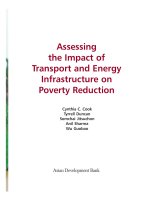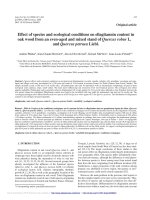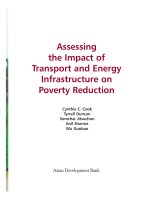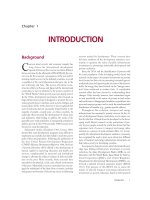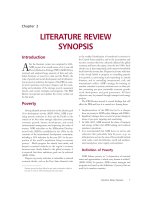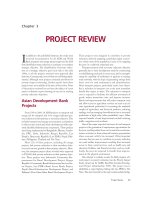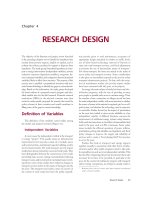Impact of bank and economic determinants on capital buffer in Pakistan banking sector
Bạn đang xem bản rút gọn của tài liệu. Xem và tải ngay bản đầy đủ của tài liệu tại đây (709.3 KB, 17 trang )
Journal of Applied Finance & Banking, vol. 9, no. 2, 2019, 125-141
ISSN: 1792-6580 (print version), 1792-6599 (online)
Scienpress Ltd, 2019
Impact of Bank and Economic Determinants on Capital
Buffer in Pakistan Banking Sector
Kashif Raza1, Jiafu Tang2, Waqas Bin Khidmat3 and Farhan Iqbal4
Abstract
This paper aims to explore the influence of bank-specific determinants as well as economy
specific variable gross domestic product (GDP) on the capital buffer in Pakistan. To investigate
this relationship 30 banks sample is selected working in the Pakistan economy in the period from
2007 to 2014. Regression and Generalized Method of Moment (GMM) models were used to
investigate relationships. The result suggested that I) GDP impact on buffer capital is positive.
II) Total Liabilities over Total Assets, liquidity bank size and lag of buffer capital put a positive
and significant effect on buffer capital. III) Non-Performing loan and loan growth impact also
positive but insignificant. IV) Return on Equity and Net Profit put negatively insignificantly
impact on buffer capital.
JEL classification numbers: G21, E32
Key Words: Banking Sector, Buffer Capital, Capital adequacy, business cycle
1 Introduction
Banks are the key player in the financial system of any country. In this present era of
globalization banking sector dealing not limited to one single country. Banks face greater risk as
compared to any other sector in global financial crises, in global financial crises banks appeal
and face significant interest. Dealings of banking sector usually have the most risky environment
as compared to other sector, so researcher always motivate to address the different issue on the
banking sector to overcome and find out the problem of the banking sector.
1
School of Management Science and Engineering, Dongbei University of Finance and Economics, China.
School of Management Science and Engineering, Dongbei University of Finance and Economics, China.
3
Dongbei University of Finance and Economics, School of Accounting, Dalian, P.R. China.
4
Liability Sales Officer, Tandlianwala Branch, National Bank of Pakistan.
2
Article Info: Received: November 12, 2018. Revised : December 17, 2018
Published online : March 1, 2019
126
Kashif Raza et al.
Capital requirement of banks is very critical, especially in financial crises. Capital requirement
and business cycle relationship is a very much essential and addressable issue in the literature.
Capital structure decision in every sector is most important topic since 1970, same as in banking
sector capital structure decisions also have great importance and very much the growing
question. Researcher concludes numeral technique and method for the optimal capital structure
technique for the baking sector.
In literature, the capital buffer is defined as the specified proportion amount of capital, that’s
banks must maintain to overcome any immediate risk. This mentioned amount helps banks to
save their operations in risky and in a financial crisis environment. This specified amount also
protect banks against insolvency crisis. Banks also hold this capital buffer for variety of
motivation and justification like 1) for growth and opportunities 2) for the reflection of
soundness towards customer and competitor having well manage capital amount 3) to ensure
themselves to full fill capital buffer amount 4) internal capital assessment model determine by
their own risk and uncertain situations.
Capital buffering bring both advantage and disadvantage for the banking sector. Restricting
banks operations within the capital amount that banks hold is margin requirement. Capital
buffering decrease the development of banks. Advantage of the capital buffer is that it’s a
parameter for the regulator to determine the vital risk management task for banks. Buffer capital
amount also a testing technique for the regulator to continually testing banks stress that they face.
Basel committee continually publishes a numeral report of capital standard and capital
measurement for the worldwide banking sector, knows as Basel I, II and III. In Basel II
regulation, provide a complete report on the importance of banking capital requirement and
instruct all central bank adopt very restrict rule of 8% of risk weight assets as a solvency
coefficient. This new polices two significant effects on the banking sector one is put dilemma on
the banking sector to maintain capital adequacy ratio, and another one is given a lot of
healthiness and abilities to the banking sector to handle the uncertain situation and also provide
the ability to absorb future losses. At the end, these new regulations also bring a lot of public
confidence in general people use as banking sector to settle financial matters.
In Basel III, capital buffer framework obliges all nations to ensure their respective banks
appropriate capital buffer rate for bank’s credit and third world dealings. This new framework
gives an idea to focus only on third country exposure that, firstly bring stability in the domestic
framework on the banking sector and secondly ensure the fallow the banking rules and regulation
to overcome the instability.
In this study, we try to evaluate the issue for the banking sector of Pakistan. All the listed bank
form both industry public and private are include to find out the determinants impact on the
banking sector in Pakistan. In this regard, we arrange panel data from to analyze the result and
taken 2009-2015 data period. Generalized Method of Moment (GMM) estimator has been
employed to reviewing the literature.
1.1 Problem Statement
Banking sector plays a very aggressive role in the financial matter of any country. Dynamic
nature of the banking sector, motivate researcher to provide a most suitable method and
technique for adoption to overcome risks. A lot of work done on this topic in a developed nation,
rather than emerging and developing nations. This study conduct on Pakistan banking sector, to
investigate the determinants put the impact of capital buffer on banking sector of Pakistan. This
study will be done to investigate the working capacity of the banking sector of Pakistan under
Impact of Bank and Economic Determinants on Capital …
127
capital buffer requirement and give an answer to the investor, customer and banking supervision
about capital buffer importance.
1.2 Literature Gap
From Pakistan point of view a lot of work done banking sectors like banking profitability and
capital structure under consideration, but from capital buffering technique, no work initially be
done. So this study provides initial step to the researcher for future capital buffering topic
emerging topic awareness and set initial step for the future study on the capital buffer.
1.3 Research Question
How lag of buffer capital affect buffer capital?
How GDP affect the capital buffer amount?
Is there any relationship between bank size and capital buffer?
Is Return on Equity (ROE) affected by capital buffer amount?
How Non-Performing loan affected by buffer capital?
Is there any relationship among buffer capital and liquidity?
Is the bank’s margin requirement affect the loan growth of the banks?
Is there any relation between banks profit and capital buffer amount?
How loan over total assets affect by bank’s capital buffering?
1.4 Objectivity of the Study
Objectivity of the study addresses the following points:
Find out the relationship among lag of buffer capital with buffer capital.
Find out the relationship between GDP and capital buffer amount.
Investigate the relationship between bank size and bank margin requirement.
To verify the relationship between ROE and bank’s margin requirement
To investigate the relationship among Liquidity and Buffer capital
To investigate the relation between Non-Performing loan and capital buffer requirement
To verify loan growth and the bank’s margin requirement relationship
Find out profit and capital buffer relationship
Investigate loan over total assets in relation with the regulatory minimum capital
requirement.
1.5 Importance of the study
This study tries to build a perfect model for the determinants from both points of view using
bank-specific factor (Return on equity, bank size, loan growth profit and liquidity) and
macroeconomic factor (GDP) impact on the buffer capital amount in the banking sector. This
study build model either this specific variable impact positive and negative and provide an ability
for taking some future decisions. From this model, banking sector take the initiative in their
operational activities in the form assets and liabilities increment or not.
128
Kashif Raza et al.
2 Literature Review
(Stolz and Wedow 2010), investigate the relationship between supervisory buffer and business
cycle taken as Germany under study. Twelve-year data taken as understudy from 1993 to 2003.
Data are categorized in two way large and small banks. The result indicates that small banks face
the greater problem as compared to bigger banks. Small banks do not maintain their risk weight
assets due to low capital for operation. The result indicate that’s low capitalization does not force
a retreat from lending.
(Atici and Gursoy, 2013), conducted a study on the Turkish banking sector to investigate the
impact of the capital buffer on bank performance form the period (1988-2009) taken 87 banks
understudy including both commercial banks and savings deposit and insurance funds. Two-step
generalized method of moments model uses to investigate the impact. Purpose of this study is to
investigate the impact of economic growth, bank size, and return on equity and Non-performing
loans on capital buffers. Data was investigated in two way firstly all 87 banks are analyzed and
secondly saving deposit and insurance funds are excluded from the overall data. The result of the
study same as Basel III that there is procyclical relation between banks capital requirement and
business cycle of the Turkish banking sector, and the countercyclical relationship between banks
when SDIF are excluded from the overall data.
(Rosa Fonseca and Gonzalez, 2009), analyzes the determinant of capital buffer on the banking
sector, 1337 banks form 70 countries using as a sample to investigate the determinant effect on
the capital buffer. The result of the study indicates that cost of deposit and market power of the
bank put a positive impact on the capital buffer, although this result varies across the countries
due to supervisory regulation and institutions own working behaviour. The result of the study
indicate two situations, one is institution quality like better disclosure of accounting matter put a
clearly positive impact on the capital buffer and also strengthen the market discipline and market
value making. Secondly, restriction on banking working but on the other way reduce the
incentive to hold capital buffer, reducing market discipline and market value making.
(Ayuso et al, 2003), conducted a study to investigate the relationship between Spanish business
cycle and banking buffer capital, taken 15-year data from (1986-2000). The result of the study
showed a significantly negative relationship between the business cycle and banking capital
buffer. The result of the study showed that 1% increase in GDP reduces 17% capital buffer.
Moreover, the result suggested that, this relationship asymmetric, and closer during the upturn.
(Jokipii and Milne, 2007) investigate the relationship between the capital buffer and the business
cycle. European countries data was collected including all type (saving commercial and large
banks) from 1997 to 2004. Results suggested that capital buffer in EU15 shows negative comovement between cycle and buffer capital. Banks working in accession countries showed a
significant positive relationship between cycle and buffer capital. Smaller banks also showed
significant positive co-movement between cycle and buffer. These all relationship between when
analyze only negative co-movement will exacerbate the procyclical impact of BASEL II.
(Lindquist, 2004) conducted study on a sample of 127 Norwegian banks to find determinants of
the capital buffer using 25 quarterly base observation from 1995q4 to 2001q4. Risk economic
growth, competitor effect, supervisory assurance and buffer determinants of a capital buffer. The
result indicates that the non-significant effect of risk on buffer capital, suggesting that more risk
Impact of Bank and Economic Determinants on Capital …
129
likely affect capital as per as BASEL II. Result also suggested that buffer capital used as
insurance against failure to meet capital buffer.
(Miguel Boucinha, 2008), examined determinants of the capital buffer of Portuguese banks taken
as an understudy. 17 Portuguese banks data were collected from the data period 1994 to 2004.
Non-performing loans, loan growth, return on assets and return on equity used as a determinant
of buffer capital. Dynamic panel data was used to find out the result. Ordinary least square
(OLS) model was used to estimate the result. Result is suggesting that larger banks maintain
less minimum capital requirement due to negative business cycle effect. Result also suggesting
that, capital ratio of banks in Portuguese must be increase as per BASEL II requirement. Buffer
capital positive influence on bank risk that why capital ratio must be increases to overcome
future losses.
(Jean-Charles Rochet, 1992), conducted a study to investigate the relationship between bank
margin requirement and commercial bank working behaviour. He analyzes this relationship
using two different approaches, firstly study result finds out when banks focus on profitmaximizing and future market growth, in this scenario capital requirement not prevent banks for
choosing the very risky or specified technique. Secondly, he finds out the result, when banks
think like a portfolio manager, in this situation capital requirement put a significant effect on
banking working. At the end, he suggested that banks must maintain capital requirement amount
as per instruction of regulatory authority maintain liquidity and overcome future defaults.
(Craig Furfine, 2001), developed a structural, dynamic and economic model how bank manage
their loan portfolio under regulatory capital, using United State banks data working in the era of
(1989-1997). This paper also investigates three major aspects of U.S banking sector an proposed
a model, three aspects are, 1) past and future regulatory capital requirement 2) changes in
regulatory monitoring and inspection criteria 3) economic ups down for U.S banking
environment. The result suggested that the decrease in loan growth but a significant impact on
capital ratio enhancement in future. Secondly, model purpose that there should be time to time
changes to renew regulatory capital restriction. All the regulatory capital maintains decision
purely base upon economic down and upturns.
(Nier and Baumann, 2006), conducted a study to examine the hypothesis, what’s the relationship
between banks provided an incentive like to overcome default risk by hold their capital margin.
To examine this hypothesis 729 individually banks data were collected from 32 different
countries; data period was used from (1993 to 2000) for estimation of the result. Using panel
data technique result are find, the result suggested that government provide a lot of safety in low
capital margin requirement, in larger capital requirement strong market discipline and banks own
accounting disclosure both are equal. Result also indicate that in government support era banks
uninsured liabilities and accounting disclosure is decrease and the government provide a high
degree of support.
(Chiara Pederzoli and Costanza Torriceli), developed a forward-looking model for the capital
requirement changing due to economy downturns. This model was the relationship between
buffer capital rates and the business cycle: (two phase’s boom and recession). Quarterly base
data of United States banks from the period (1971-2002) was used to forecast this capital
requirement and the business cycle. The model indicates that capital requirement reduces the risk
of sensitivity and defaults, and buffer capital also reduces the procyclicality.
130
Kashif Raza et al.
(Skander J. Van den Heuvel, 2008), conducted a study to find out welfare cot of banking capital
requirement. United State banks data was used to developed find out welfare cost of capital. The
result showed that buffer capital reduced the bank's liquidity for operation. Result also indicate
that return on assets gives strength to the liquidity of the banks. The welfare cost of capital is
equivalent to capital adequacy regulation permanent loss in consumption up to 0.1% to 1%.
(Arturo Estrella, 2004), developed a dynamic model for cyclical behaviour of optimal capital.
For the development of model U.S banks data was collected from the period (1984 to 2003). The
result of the study predicts that value at risk (loans) is positively correlated with optimal flows of
external capital flows. On the other way, VAR is negatively correlated with net changes in
capital flows within the banking sector of the U.S. Finally result suggested that a minimum
regulatory capital based upon the value at risk. This model also suggests a number of valuable
techniques to manage banks capital risk.
Regulatory authority continuously changes banks margin requirement, for the better economy
and flow of finance. In running an economy lot of factor that’s put some effect on banks margin
requirement either positive and negative. U.S banks data was used to investigate the relationship
between, increases in assets can put significantly effect on the capital building. In this research,
we find no evidence between the capital building and assets growth. U.s Banks data from the
period the early 1990s, the result showed that, long cross-sectional relationship between assets
risks and banks capitalizations, Mark J. Flannery and Kasturi P. Rangan (2008).
Alan D. Morrison and Lucy White (2005), conducted a study to develop a model generalize
equilibrium model to investigate adverse selection and moral hazard in the banking sector. This
model suggests that supervisory authority should develop a proper screening method for both
banks, existing one and newly enter banks. The study indicated that regulatory authority should
have skill person’s team for conducted post-ex-audit and also have in-depth information about
the market to analyze possible return of new projects. Regulatory authority should impose capital
adequacy requirements on banks. The capital requirement is a very much important tool for
regulatory authority for screening. The capital requirement also reduces moral hazard and
adverse selection in the banking sector. Tight capital requirement policy reduces default of the
banking sector and also provide strong strength to economic growth.
The financial sector (Banking sector) is a back bone of any economy. Banking sector acts as a
leading sector of any economy. Pakistan economy face a lot of distress, downturns from last two
decays, there is a number of causes of this distress like terrorist attack, political instability and
lack of planning for future events. Purpose to select this topic is very critical, the banking sector
of Pakistan face a lot of trouble from last three decays, nationalization and denationalization put
a lot of pressure on banking working and profitability. Regulatory authority (SBP) also
implement a number of rule and regulation for the constant operation of the banking sector.
Comparatively to other sector banking sector face more pressure and restriction from the
regulatory authority in working. All the banks operate in the entire world must deposit
mentioned amount of proportion at regulatory account. Same as other countries rule and
regulation Pakistan banking regulatory also adopt this measure (Buffer capital) for the smooth
working of the bank sector. Aim to select this topic is to investigate what’s the factor should
banks adopt to support this buffer capital decision from regulatory authority (SBP).
Impact of Bank and Economic Determinants on Capital …
131
3 Methodology
The methodology of the paper is arranged in the following manner.
3.1 Population and Sampling
All are currently working banks in Pakistan economy including (Public sector, Private sector,
Specialized Banks and all Development Financial Intuitions) considered as a population of study.
Thirty banks from three sectors (Public, Private and Specialized sector) selected as a sample to
find out determinants capital buffer of Pakistan. Appendix 1 showed complete detail of selected
banks like bank name, belonging category and official website.
3.2 Data period, Data source and Collection
For investigating capital buffer determinants, 8-year data is collected from (2007 to 2014). Data
is collected from the official website of respective banks, the annual report of all selected banks
and the state bank of Pakistan financial statement analysis also used for the collection of the data.
3.3 Variables
3.3.1 Dependent variable
Buffer Capital (minimum regulatory amount, held by State bank of Pakistan) of respective year
and the respective selected bank used as dependent variable. Capital buffering is calculating by
the difference of regulatory capital and maintained capital and divided by total assets.
3.3.2 Independent variable
Gross Domestic Product (GDP), Return on Equity (ROE), Bank Size (BS), Non-Performing
Loan (NPL), Net Profit (NP), Liquidity (LIQ), Loan Growth (LONGR) and Net Loan / Total
Assets (TLTA) are used as independent variables (as determinant of capital buffer).
3.4 Model
Following equation is used to find the determinant effect on the capital buffer.
BUFFCAPit = β0 + β1 BUFFCAPi, t − 1 + β2 GDPt + β3 ROEit + β4 BSit + β5 LIQit +
β6 NPLit + β7 NPit + β8 LONGRit + β9TLTAit + £it
(1)
In equation 1, BUFFCAP is capital buffer of bank i in year t. We measure capital buffer by the
given instructions of the regulatory authority (SBP) in its publication. GDP is an annual growth
of gross domestic product in year t. ROE is the proxy of net profit after tax over total equity of
bank i in year t. BS represent bank size and calculated by the natural logarithm of total assets of
bank i in period t. NPL represent Non-performing loan of bank i in period t. NP is the net profit
after tax of bank i in period t. LONGR is the indicator of the growth of loan of bank i in year t.
We assume TLTA is proxy of the total loan over total assets of bank i in year t. £ represent error
term in year t of bank i.
Variable in above equation BUFFCAPi t-1 used as lagged of dependent variable intended to
capture the persistence of capital buffer, argue by Ayuso et al. (2004), Fonseca and Gonzalez
132
Kashif Raza et al.
(2010) and Atici and Gursoy (2013), used as adjustment cost and also put positively and
significant effect on buffer capital, so we also expected positive sign from result.
GDP used as the macroeconomic indicator in this study and the positive sign is expected due to
the impact of the business cycle on buffer capital as arguing by Ayuso et al. (2004) and Atici and
Gursoy (2013).
BS in equation (1) used as a proxy of bank size and calculated by taken natural logarithm of net
assets, Stolz and Wedow (2004), Alfon and Argimon (2005) and Atici and Gursoy (2013)
showed a negative relationship between buffer capital and Bank size. We also assume negative
sign by consider the following reason; large bank has great capabilities and opportunities for
easily approaching the capital market and also have a strong reputation for capturing investment,
so that way large bank bear unexpected rise in margin requirement.
Return on Equity (ROE) bank-specific control variable also include in equation 1, to investigate
the impact on Buffer capital. ROE is the proxy of net income after tax divided by total equity of
respective bank in a respective year. In a previous study negative relation is find out between the
capital buffer and ROE. Alfon et al. (2005) and Ayuso et al. (2004) and Boucinha (2008) find out
the negative impact of ROE on Buffer capital, negative sign suggests that higher the cost of
capital showed negative sign. Some study contradicts from this result like Berger (1995),
Flannery and Rangan (2008) and Nier and Boucinha (2006) found a positive relationship
between buffer capital and ROE. The positive sign indicates that, asymmetry information in
banking sector a large proportion of banks earning kept in retained earnings that hidden retained
earnings increase the capital ratio of the banks.
In equation 1, Non-Performing Loan (NPL) used as third bank-specific control variable. Ayuso
et al. used as independent variable in his study as a determinant of a capital buffer. Same as
ROE, two contradict result of NPL find out in the previous research, positive and negative. The
positive sign showed that, if bank managers and sets its risk portfolio according to regulatory set
rule and regulation, then the positive sign will be expected. A negative sign indicates that, if
banks make their portfolio riskier, risk lower the capital ratio results, so negative sign will be
accepted.
Next variable in equation 1 us Net Profit, profit result also dynamic in nature, some studies like
Lindquist (2004) and Atici and Gursoy (2013) positive and negative relationship respectively,
among capital buffer and profit, positive sign indicate that high profit mean high retained
earnings, increase in retained earnings increases the capital ratio of the banks. Jokipii and Milne
(2008), find out the negative relationship among variables, indicate that the increase in profit,
increases in retained earnings, this incensement leads to increase the capital buffer proportion at
regulatory authority.
Loan growth is the next variable in equation 1, Atici and Gursoy (2013), the study showed
negative and significant of loan growth on the capital buffer. Both results can be expected from
this variable on buffer capital; positive result suggested that banks perfectly manage their loan to
overcome the risk and earning from the loan is stable and increase the capital ratio. On the other
side same as NPL result, Boucinha (2008), loan growth enables banks to capture changes in
Impact of Bank and Economic Determinants on Capital …
133
credit demand, if banks not properly manage the increase in credit demand, this will lead to a
reduction in buffer capital.
TLTA is the proxy of the total loan over total assets, used as a measurement of risk; this ratio
indicates how much banks have total assets against the full filament of total liabilities. Loan over
total assets also point out banks potential risk. So due to the measurement of potential risk
positive sign is expected from this variable. Some studies showed negative relation among TLTA
and buffered capital, Fonseca and Gonzales (2010) showed the negative relationship of TLTA
with buffer capital, negative sign indicate that banks that have a high loan as compared to their
total assets put a negative impact on their buffer capital holdings.
3.5 Hypothesis
H1: There is a significant positive relationship between lag of the dependent variable.
H2: There is a significant positive relationship between GDP and buffer capital.
H3: There is a significant negative relationship between ROE and buffer capital.
H4: There is a significant positive relationship between Bank Size and buffer capital.
H5: There is a significant positive relationship between Liquidity and Buffer Capital
H6: There is a significant negative relationship between Non-Performing Loan and buffer
capital.
H7: There is a significant positive relationship between Net Profit and buffer capital.
H8: There is a significant negative relationship between Loan Growth and buffer capital.
H9: There is a significant positive relationship between Total Loan over Total Assets and buffer
capital.
3.6 Variable Calculation and Expected Sign
Variables
Expected
Sign
Calculation
Proxy
Req Reserve – Maintained Equity / Total
assets
BUFFCAP
Buffer Capitali t-1
Req Reserve t-1 – Maintained Equity t-1 /
Total assets t-1
BUFFCAPt-
Gross Domestic Product
GDP
GDP
+
Return on Equity
Net Profit after Tax / Total Equity
ROE
+
Bank Size
Natural Logarithm of Total Assets
BS
-
Liquidity
Cash and Cash Equivalent / Total Assets
LIQ
+
Dependent Variable
Buffer Capitalit
Independent Variable
+
1
134
Kashif Raza et al.
Non-Performing Loan
Natural Logarithm of Non-Performing
Loan
NPL
-
Net Profit
Natural Logarithm of Net Profit
NPROFT
+
Loan Growth
Current year loan / previous year loan
LNGR
-
TLTA
Total Liabilities/ Total Assets
TLTA
+
3.7 Theoretical Frame Work:
Gross Domestic
Product
Return on Equity
Bank Size
Non-Performing Loan
Net Profit
Loan Growth
Total Loan over Total
Assets
Buffer Capital
Impact of Bank and Economic Determinants on Capital …
135
4 Empirical Result
4.1 Descriptive Statistics
Table 1 shows descriptive statistics of all variables (Buffer capital, lag capital buffer, bank size,
return on equity, liquidity loan growth, non-performing loan, net profit and total loan over total
assets. From the selected data period (2007-2014) buffer Capital Mean (Median) -0.015%
(7.8%). Buffer capital means result indicates that in the data period chosen all banks averagely
maintain (-0.015%) buffer capital. Lag behind buffer capital result Man (Median) 4.9% (7.8%).
Mean (Median) of bank size proxy of the Natural logarithm of Total Assets Result, mean 18.29
thousand rupees and median 18.59 thousand rupees.
Table 1: Descriptive Statistics
BUFFCAP
BUFFCAPt-1
BS
ROE
LIQ
GDP
LNGR
NPL
NPROFT
TLTA
Mean
-0.00519
0.049497
18.2957
-0.0973
0.09484
3.296886
0.222736
14811535
3101773
0.6432
Median
0.07802
0.078373
18.5901
0.07176
0.08211
3.169351
0.110407
6189845
649159.5
0.520208
Maximum
8.87326
8.873256
21.3476
2.34715
0.3569
4.832817
4.2139
122000000
31819590
13.47568
Minimum
-6.48863
-6.488626
8.51494
-14.743
0.01272
1.606681
-0.92027
0.0000
0.0007
0.248523
Std. Dev.
1.22121
1.311189
2.00766
1.25747
0.04608
1.208591
0.503227
19980194
6504223
1.046416
Skewness
0.90771
2.18649
-2.0147
-9.5693
1.64409
-0.08218
4.421974
2.509437
1.785186
10.54727
Kurtosis
33.4113
32.04289
10.3394
103.126
7.83021
1.547298
27.92934
10.6035
6.201407
119.6154
Observations
240
240
240
240
240
240
240
240
240
240
The average return on equity that’s given by selected banks in the data period -9.73%. Mean
result of return on equity indicted that in the selected data period Pakistan banking sector faces
stress in their operational working due to a lot of regulation restriction and as well economic
pressure, comparatively less return from another sector. Liquidity result mean (Median) in table
1, 9.484% (8.211%). The average result of liquidity proxy of Cash and Cash equivalent divided
by total assets shows in the selected data period from 2007-2014 liquidity of Pakistani banks
9.484%, so Pakistani banks highly liquid and perform their operation very effectively. Mean
result of Gross domestic product in the selected data period 3.29. Loan growth of the banking
sector is very much important proxy, increase in loan growth predict that banks working in the
economy easily manage their loan portfolio for earning. In the selected data period from 2007 to
2014 Pakistani banks loan growth 22.2%, loan growth average result shows banks working in the
Pakistan economy continuously manage their loan portfolio for earning a profit. Mean (Median)
136
Kashif Raza et al.
results of Non-Performing loan 14811535 (6189845) thousand rupees, mean result indicates that
in the selected data period of eight years from 2007-2014 non-performing loan of Pakistani
banks 1.4 billion. Mean result of Net profit 3101773. The ratio of the total loan over total assets
means (median) results in 64.32% (52.02%). The result of the total loan over liabilities shows in
the selected data period banks have 64% burden of liabilities on their 100% total assets.
4.2 Correlation Result
Table 2 shows correlation result among selected variables; result shows lag behind buffer capital
liquidity, loan growth and total loan over total assets have significantly correlated with buffer
capital. Previous year observation of buffer capital positively significantly correlates with buffer
capital, indicate that banks must increase their buffer amount for any sudden disaster in
operational working. Buffer capital basically the extra amount that banks maintain to overcome
any sudden operational disaster so the result of correlation also suggest that banks must maintain
this extra proportional amount for any operational working risk reduction. Bank size also shows
positive correlation with buffer capital.
Table 2: Correlation Result
BUFFCAP
BUFCAPt-1
BS
ROE
LIQ
GDP
LNGR
NPL
NPROFT
TLTA
BCAP
BUFF
BS
ROE
LIQ
GDP
LNGR
NPL
NPROFT
TLTA
1
0.8976**
0.0083
-0.0024
0.1375*
-0.0075
0.1802**
0.0123
0.0346
0.5565**
1
-0.0355
-0.0014
0.1139
-0.0242
0.1554*
-0.0167
0.01
0.5144**
1
0.09211
0.07324
0.07775
-0.1324*
0.3939**
0.4379**
-0.298**
1
0.0116
0.0629
0.0352
0.0564
0.199**
-0.0084
1
-0.0708
0.10225
-0.0135
0.11527
-0.0971
1
0.0603
0.0722
0.1221
-0.040
1
-0.1**
-0.18
0.11
1
0.47
-0.1
1
-0.0906
1
*. Correlation is significant at the 0.05 level.
**. Correlation is significant at the 0.01 level.
Banks have highly operational assets for earning provide the ability to banks to maintain a high
amount of buffer capital. Assets size up to 0.83% increases banks buffer capital amount easily be
maintained 100% for any sudden operational breakout.
The relationship among return on equity and buffer capital is positively correlated. Banks have
high proportional amount buffer capital also have a high return on equity, buffer capital
increment support the working of banks and banks easily got up high desire return on equity goal
for the attraction of investor, deposited and creditor.
Liquidity result also positive but significant sign up to 5% confidence level also observed among
this relationship. So correlation result among liquidity and buffer capital indicate that highly
liquid banks high amount of buffer capital to full sudden of operations. The effect of liquidity
shows highly liquid banks have highly buffer amount for the full filling any sudden operational
Impact of Bank and Economic Determinants on Capital …
137
breakage. Banks that have 13.5% liquidity, banks working in the Pakistan economy easily
achieve buffer capital maintaining level.
The downfall in the economy of country banking operation also faces a lot of trouble in case of
deposit and loan portfolio. In table 1 Gross domestic product shows a negative correlation with
buffer capital. Mean decrease in the economy of a Pakistan bank buffer capital also faces trouble,
in economy downturn bank also focus on saving from any operational downturn they more focus
on the working instead on maintain extra amount for future. This result also predicts Economy
downturn also put an impact on the bank working, so banks buffer capital also decreases for
wellbeing, when the economy in recession face. Macroeconomic factors like (GDP, Inflation)
too very much crucial for bank working, these factors also put an impact on the working banking
sector.
Non-performing Loans also shows a positive correlation with buffer capital. Banks loan that has
not in the strong performance for the generation of profit, banks must think about that loans, how
those loan risk can be reduced, so banks increase their buffer capital to overcome risk.
Loan growth and total loan over total assets also show positively significant correlation with
buffer capital; mean banks must maintain extra amount for the advancement in loan growth and
also overcome the debt burden for both financial and non-financial liabilities. Net profit also
indicates that banks in case high profit and also for the high achievement profit earning must
maintain buffer capital.
4.3 Regression Analysis and GMM Analysis
Table 3 shows the regression result of the study.
1 = −1.329518 + 0.7450541 𝐵𝑈𝐹𝐹𝐶𝐴𝑃𝑖 𝑡 − 1 + 0.051481 𝐵𝑆𝑖𝑡 − 0.005766 𝑅𝑂𝐸𝑖𝑡
+ 1.436121 𝐿𝐼𝑄𝑖𝑡 + 0.013342 𝐺𝐷𝑃𝑡 + 0.104973 𝐿𝑂𝑁𝐺𝑅𝑖𝑡 + 9.98𝐸
− 10 𝑁𝑃𝐿𝑖𝑡 − 7.53𝐸 − 10 𝑁𝑃𝑖𝑡 + 0.200553𝑇𝐿𝑇𝐴𝑖𝑡
Above equation clearly define the regression result of the study. The result shows intercept of the
equation -1.329. Impact of the previous year buffer capital maintains amount is positive and
significantly. Previous year buffer capital positive relationship indicates that banks must
maintain some extra amount to full fill its operational risk aversion. Highly banks buffer capital
amount highly banks stable working. So banks must maintain a buffer amount. This result also
explains the previous study of Ayuso et al. (2004), Fonseca and Gonzalez (2010) and Atici and
Gursoy (2013) positive and significant relation among lagged buffer capital amount.
Table 3: Regression Result
Variable
C
BUFFCAPt-1
BS
ROE
LIQ
GDP
Coefficient
Std. Error
-1.329518
0.745054
0.051481
-0.005766
1.436121
0.013342
0.383263
0.030601
0.019988
0.027068
0.751826
0.027986
t-Statistic
Prob.
-3.468949
0.0006
24.34769
0.0000
2.575567
0.0106
-0.213033
0.8315
1.910178
0.0574
0.476743
0.634
138
Kashif Raza et al.
LNGR
NPL
NPROFT
TLTA
0.104973
9.98E-10
-7.53E-10
0.200553
0.069003
1.97E-09
6.30E-09
0.03987
R-squared
Adjusted R-squared
S.E. of regression
Sum squared resid
Log-likelihood
F-statistic
Prob(F-statistic)
0.829569
0.8229
0.513925
60.74729
-175.6753
124.3914
0
Mean dependent var
S.D. dependent var
Akaike info criterion
Schwarz criterion
Hannan-Quinn criteria.
Durbin-Watson stat
1.521291
0.506034
-0.119517
5.030142
0.1296
0.6133
0.905
0.000
-0.00519
1.221211
1.547294
1.692321
1.605729
1.518517
Bank size also put positive infusion on bank maintain buffer capital, increase in 51% bank total
assets put positively and significant impact on bank buffer capital. This result contradicts from
some previous studies, Stolz and Wedow (2004), Alfon and Argimon (2005) and Atici and
Gursoy (2013), they argue banks size put the negative impact of bank buffer capital. The result
of bank size shows an increase in bank working assets (size) bank should increase its buffer
capital amount.
Return on equity (ROE), the relationship among Buffer ratio and ROE negative but insignificant,
banks have high-level buffer ratio decrease return on equity. Banks more focus on buffer ratio
decrease in return on equity put the negative worth of amount in a market and investor and
creditor and depositor feel hesitation in investment. This positive relation same as previous
studies of Berger (1995), Flannery and Rangan (2008) and Nier and Boucinha (2006) found a
positive relationship between buffer capital and ROE. On the other way, this result also
contradicts from some past studies that found a negative association in their finding like Alfon et
al. (2005) and Ayuso et al. (2004) and Boucinha (2008) find out the negative impact of ROE on
Buffer capital. From this positive relationship, we conclude that this positive relationship
between ROE and buffer capital ratio shows the cost of capital is very much low in Pakistan
economy, and banks efficiently manage capital for operations.
Liquidity ratio cash and cash equivalent, in the selected data period also shows positively and
significantly impact on Buffer capital. Banks have a highly liquid asset such as cash and cash
equivalent securities like Receivable and T-bills, have better buffer capital comparatively to less
liquid banks. The economic downturn also has a significant relationship with bank working,
because banks directly involved in economic activities. Result suggests that an economic boom
period banks also have better and well maintain buffer capital comparatively in an economic
recession.
Banks earn profit from two significant ways, one issuing loans and secondly providing financial
services. Basic earnings (Interest) of banks from loans issuing, so banks have a high amount of
loan publishing from other have a high amount of buffer capital. The non-performing loan also
has a positive impact on buffer capital but the too much little impact and even insignificant. So
banks non-performing loan not put some substantial impact on buffer capital.
Impact of Bank and Economic Determinants on Capital …
139
A result of the model shows that, Net profit put a native impact on buffer capital, this result
support some previous studies of Jokipii and Milne (2008), find out the negative relationship
among variables, this negative relationship suggests that banks profit increases the retained
earnings, this cause increases the regulatory proportional, so banks buffer capital decreases.
Total loan over total assets used as a measurement of risk, the high result of this ration shows top
risky banks; this ration also put a positive and significant impact on bank buffer capital. Positive
sign predicts that banks have high risk-taking environment and banks have risk-taking
management for high profit, must have high buffer capital. This positive relationship is
contradicting from some previous studies of Fonseca and Gonzales (2010). They find a negative
relationship between TLTA and buffer capital.
5 Conclusion
This current study tries to investigate the relationship among bank buffer capital and two major
factors that put an impact on this amount, banks specific and country macroeconomic factor. For
investigating this relationship banks, specific factors include Bank size, Return on Equity, loan
growth, non-performing loans, total loans over total assets ratio and net profit and liquidity.
Macroeconomic factor consists of the gross domestic product (GDP).
Same as some previous studies mix of a positive and negative result is obtains. Some variable
put positively and significantly influence and some as negatively significantly impact on buffer
capital that’s banks maintain for their operational distress. The primary purpose of this study
tries to evaluate some critical measure from both banks factor and country-specific factor for the
maintaining of capital buffer amount.
Try to evaluate this relationship Pakistan 30 banks from all sector except internal banks and
micro financial institution used as a sample. 2007 to 2014 seven-year data period is used to
investigate relationships among bank buffer capital and bank-specific factor and macroeconomic
factor. Result suggests that banks must maintain their buffer capital amount according to the
economic condition of the country. Pakistan like a country that have more volatile economic due
to the internal disability of efficient control on political uncertainty and planning adequacy for
future and also too much unpredictable due to a lot of terrorist attack and energy failure, banks
must move and make their financial strategies according to economic downturns. The result
indicates that banks in the boom economy increase their buffer amount and in rescission decrease
their buffer capital amount.
Bank specific capital Bank size, liquidity, loan growth, non-performing loan and total liabilities
over total assets put a positive impact on buffer capital, so banks working in the Pakistan
economy increase these ratios for improvement of buffer capital amount. Further results of the
return on equity and net profit put a negative impact on the buffer capital. Banks in high profit,
increase in retained earnings, so regulatory restriction compel banks for the to maintain of the
reserve requirement, so banks most involved in financial services instead involve in too much
profit activities and risk-taking activities. So, this study suggests that banks more focus on the
asset’s growth, loan growth and liquidity for the achievement of optimal level buffer capital.
This study also provides initial framework to researcher and student to investigate the
relationship among buffer capital and banks specific factor and economic factor with categories
140
Kashif Raza et al.
of banking sector like Islamic and conventional sector. The researcher also conducts comparative
studies with some other growing economies just like Pakistan economy.
References
[1] Atici, G. & Gursoy, G. (2013). The Determinants of Capital Buffer in the Turkish Banking
System. International Business Research, 6, 224-234. ISSN 1913-9004 E-ISSN 1913-9012.
doi:10.5539/ibr.v6n1p224 URL: />[2] Ayuso, J. Pérez, D. & Saurina, J., (2004). Are capital buffers pro-cyclical? Evidence from
Spanish panel data. Journal of Financial Intermediation, 13, 249–264. Retrieved from
/>
[3] Berger, A. N., (1995). The Relationship between Capital and Earnings in Banking. Journal
Money, Credit, and Banking, 27. 432-456. doi:11.1116/j.jmcb.1995.12.001
[4] Boucinha, M., (2008).The Determinants of Portuguese Banks’ Capital Buffers. Estudos e
Documentos de Trabalho, Working Papers.
[5] Estrella, A., (2004). The cyclical behavior of optimal bank capital. Journal of Banking &
Finance, 28, 1469–1498. Retrived from http:// www.elsevier.com/locate/econbase
[6] Fonseca, A, R., & González, F. (2010). How bank capital buffers vary across countries: The
influence of cost of deposits, market power and bank regulation. Journal of Banking &
Finance, 34, 892–902. Retrived from: htpp:// www.elsevier.com/locate/jbf
[7] Furfine, C., (2001). Bank Portfolio Allocation: The Impact of capital Requirement,
Regulatory Monitoring, and Economic Conditions. Journal of Financial Services Research,
20:1, 33-56.
[8] Jean-Charles, R., (1992). Capital requirements of commercial banks and the behaviour.
European Economic Review, 36, 1137-l 178. Retrived from, European Economic Review,
1993 Publishing.
[9] Jokipii, T, & Milne, A., (2008). The cyclical behaviour of European bank capital bufferz.
Journal of Banking & Finance, 32, 1440–1451. doi:10.1016/j.jbankfin.2007.12.001
[10] Kjersti-Gro, L., (2004). Banks’ buffer capital: how important is risk. Journal of
International Money and Finance, 23, 493–513.doi:10.1016/j.jimonfin.2004.01.006
[11] Morrison, A, D., & White, L. (2005). Crises and Capital Requirements in Banking. The
American Economic Review, 5, 1548-1572. Retrived from. American
Economic Review.
[12] Nier, E., & Baumann, U. (2006). Market discipline, disclosure and moral hazard in banking.
Journal of Financial Intermediation, 15, 332–361. />[13] Peura, S., & Jokivuolle, E, (2004). Simulation based stress tests of banks’ regulatory capital
adequacy.
Journal
of
Banking
&
Finance,
28,
1801–1824.
doi:10.1016/j.jbankfin.200.11.004
[14] Pederzoli, C. & Torricelli, C., (2005).Capital requirements and business cycle regimes:
Forward-looking modelling of default probabilities. Journal of Banking & Finance, 29,
3121–3140. doi:10.1016/j.jbankfin.2005.12.001
[15] Stolz, S., & Wedow, M. (2011). Banks’ regulatory capital buffer and the business cycle:
Evidence for Germany. Journal of Financial Stability, 7, 98–110. Retrived from http://
www.elsevier.com/locate/jfstabil
Impact of Bank and Economic Determinants on Capital …
141
Appendix 1 Bank and their official website
Public Sector Banks
1) Bank of Punjab
2) National Bank of Pakistan
3) The bank of Khyber
/> /> />
Specialized Sector
1)
2)
3)
4)
Zari Taraqiati Bank Limited
Small Medium Enterprises Bank limited
Industrial Development Bank Limited
The Punjab provisional corporation bank limited
/> /> /> />
Private sector
1) Allied bank limited
2) Askri bank limited
3) Bank al falha limited
4) Bank al habib limited
5) Bank islami pakistan limited
6) Faisl bank limited
7) Habib bank limited
8) Habib metro bank limited
9) Js bank limited
10) Mcb bank limited
11) Meezan bank limited
12) Nib bank limited
13) Samba bank limited
14) Silk bank limited
15) Sonari bank limited
16) Standard chartered bank limited
17) Summit bank limited
18) United bank limited
/> /> /> /> /> /> /> /> />http:// www.mcb.com.pk
/> /> /> />
/> /> />



